Eriogonum codium
Rhodora 97: 350, fig. 1. 1997.
Herbs, matted, not scapose, 0.3–1 × (1–) 2–7 (–9) dm, tomentose, greenish. Stems matted, with persistent leaf-bases, up to 1/4 height of plant; caudex stems matted; aerial flowering-stems erect, slender, solid, not fistulose, 0.2–0.9 dm, floccose. Leaves basal, fasciculate in terminal tufts; petiole 0.2–0.8 (–1) cm, tomentose; blade oblanceolate to elliptic, (0.5–) 0.6–1.2 × 0.3–0.6 cm, densely white-tomentose on both surfaces, margins plane. Inflorescences cymose-umbellate or cymose, 1–2 × 1–4 cm, tomentose; branches dichotomous, floccose; bracts triangular, scalelike, 1–2.5 mm. Peduncles erect, slender, (0.15–) 0.2–0.5 (–0.7) cm, floccose. Involucres 1 per node, turbinate-campanulate, 2.5–4 × 2–2.5 mm, membranous, tomentose to floccose; teeth 5, erect, 0.8–1.2 (–1.5) mm. Flowers 2–3 mm; perianth lemon yellow, thinly tomentose; tepals connate proximal 1/2, monomorphic, broadly oblong to oblong; stamens slightly exserted, 2.5–3.5 mm; filaments sparsely pilose proximally. Achenes light-brown, 2.5–3 mm, sparsely tomentose.
Phenology: Flowering May–Aug.
Habitat: Gravelly volcanic soils, mixed grassland, saltbush and sagebrush communities
Elevation: 300-400 m
Discussion
Of conservation concern.
Eriogonum codium is a potentially endangered species known from a single site on volcanic bluffs overlooking the Columbia River in Hanford Research National Monument in Benton County. It is worthy of cultivation as a rock-garden plant, although little or no sexual reproduction is known in the natural population. The Umtanum Desert wild buckwheat is a candidate for federal listing and is considered an endangered species by the state of Washington. Much of the population was destroyed in a man-caused fire in 1997. The species is in the Center for Plant Conservation’s National Collection of Endangered Plants.
Selected References
None.
Lower Taxa
"/2" is not declared as a valid unit of measurement for this property."dm" is not declared as a valid unit of measurement for this property."dm" is not declared as a valid unit of measurement for this property."dm" is not declared as a valid unit of measurement for this property.
